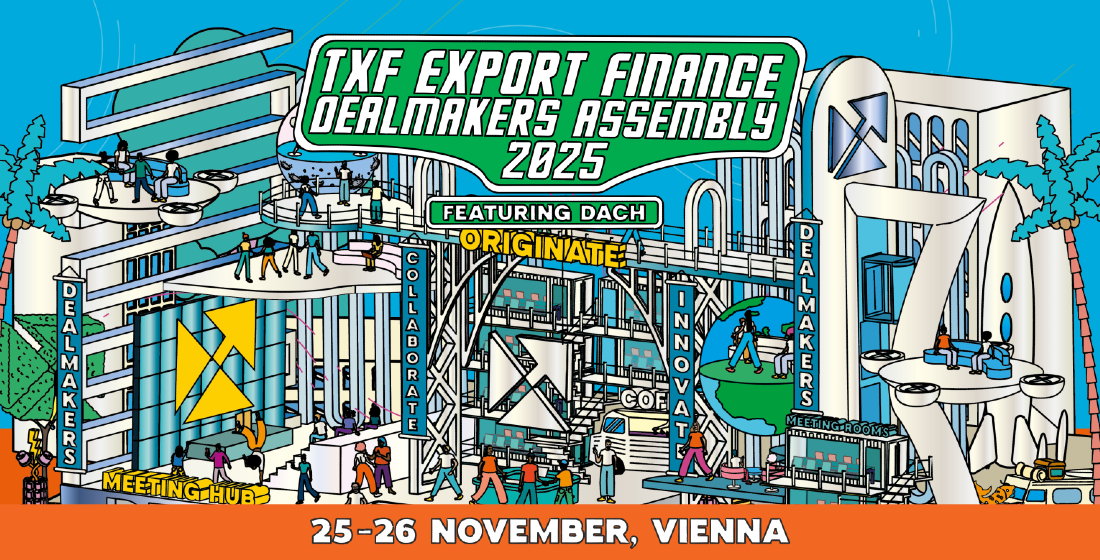Export finance in the Covid-19 epoch
TXF’s editor Max Thompson takes a look at how the export finance landscape - including the super low CIRR rate on offer - is faring amid the crisis, and what the market might look like going forward.

ECAs were quick out of the blocks to introduce new tools and adapt existing products to help mitigate the economic fallout for the trade, export and project finance community from the impact of the coronavirus pandemic. After all, ECAs are a unique countercyclical economic policy tool.
Five months into the crisis, distressed portfolios for certain sectors - particularly transport and oil and gas, which have been hit hard by lack of revenues - continue to result in ECAs granting waivers in respect of covenant breaches, repayment holidays and concessions to importers and exporters caught off guard by the crisis.
Coupled with consequential portfolio credit downgrades, the risk profiles of certain lending portfolios have heightened, creating an environment where considering increased risk appetite on new deals has become challenging. It is important to note, the Covid-19 pandemic is not a liquidity crisis like the GFC of 2008-12, rather it has been more economic supply and demand-led.
In short, while the creditworthiness of distressed borrowers has weakened, there is still adequate market liquidity to get ECA-backed deals across the financial line, especially if the transaction was in the pipeline pre-pandemic.
Last month for example, the multi-sourced Total-led Mozambique LNG financing signed, with heavy ECA backing, followed by the Kexim-covered Jawa 9 and 10 ultra-supercritical coal-fired power project in Indonesia. And two landmark green ECA-backed loans also closed amid the crisis: Saudi Arabia's Ministry of Finance raised SAR1 billion ($266.65 million) to buy buses with cover from Euler Hermes and the UK’s National Grid signed the first multi ECA-covered green loan, guaranteed by SACE with SIMEST CIRR support and Euler Hermes, to help finance a €2 billion subsea electricity cable project.
So, as governments look to rebuild their economies around SDGs, ECA debt is emerging as a new and attractive instrument in sovereign/non-sovereign borrowers' financial toolkits, proving export finance is paramount to achieving the realisation of more sustainable infrastructure projects.
But pure export finance contracts or MLT buyer’s credits have been few and far between, with deal flow significantly down, and project financings or refinancings (the Ichthys LNG refi closed despite the fall in oil prices) accounting for the lion’s share of ECA activity.
Come together
ECAs are vital in supporting the economic recovery phase globally, and their role is only going to become more prominent as DFIs and multilaterals stretch to combat Covid and the climate change crisis. Increased ECA flexibility and risk mitigation procedures, as well as tenor extensions and enhanced liquidity, are just a few of the recent trends touted by market observers to be accelerated by the crisis.
ECAs have already reacted rapidly and in different measures to the pandemic. However, the ECA response has been on an individual basis rather than a collective one, which needs to be remedied, especially for increased multi-sourced ECA-backed project finance deal flow going forward.
Some emerging market buyers have been neglected by ECAs too, as the majority of measures implemented at the beginning of the crisis were focused on exporters in support of their working capital requirements. Therefore the impact of the crisis is expected to be prolonged for certain buyers, particularly in emerging markets, where the need is critical for financing key infrastructure projects and capital expansion projects.
Increased ECA collaboration has long been hailed as the solution for agencies to take a more holistic approach to large-scale projects. But tangible products and procedures are yet to materialise a more coordinated and timely approach by ECAs. Making the ECA product offering highly relevant to a range of borrowers across diverse industries and regions would certainly be a start.
There have already been calls for 100% cover from ECAs, which would leave no residual risk for the private market. As in some cases, for instance, the heightened risk perception is making it difficult for buyers in emerging markets to raise the 15% down payment financing traditionally required for ECA-covered deals.
Other measures could be in the form of temporary or permanent relaxation of certain OECD Consensus rules, such as the local content requirements which would increase the ECA eligible component of projects. More reinsurance agreements between OECD and non-OECD ECAs would also help agencies manage capital while upping collaboration.
Super low CIRR
The general market consensus is that while buyers reassess the priorities of their various projects, ECA-backed deal volumes will remain subdued for the rest of 2020.
But with the benefits of the super low Commercial Interest Reference Rates (CIRR) rates - the minimum interest rate an OECD ECA can charge for direct loans - ECA pricing remains a head turner for corporate borrowers. For euro-denominated ECA financing (for repayment periods of 8.5 years or longer), CIRR is currently at 0.41% fixed - with no commitment fees, while the dollar-denominated debt equivalent is 1.46%.
Taking the ECA route, at least for borrowers tapping tied OECD ECA direct loans, is a no-brainer when looking for attractive pricing, especially given an increase in the cost of funding for international banks has caused an uptick in the overall cost of financing. Although, one borrower admits the rise in the cost of ECA-backed debt has “not been significant” amid the Covid-19 crisis - so far at least.
But as government borrowing balloons to provide the economic life support their hard-hit countries need, the question is: will ECAs’ country limit exposures be tree topped to help balance the books? Or will governments’ allocated ECA budgets be upped while agencies’ capital market fundraising activities are curtailed? Only time (and another global Covid-19 outbreak) will tell.
Now time to get up to speed with the markets
Here's a selection of original TXF Subscriber articles recently published
BNDES: A little more like other DFIs
BNDES is shifting its mandate, with project origination and structuring now higher on the corporate agenda, as Brazil’s DFI looks to attract other sources of financing to the country.
Braskem raises $225m loan for Texan polypropylene facility
Brazilian petrochemical company Braskem has raised a $225 million loan to finance the construction of its polypropylene production facility project in La Porte, Texas.
SMB Offshore finalises guarantee for Liza Destiny FPSO debt
Dutch oil and gas company SBM Offshore witnessed its pre-completion parent company guarantee for the $720 million debt package backing its Liza Destiny FPSO project released on 31 July.
Petron sounds out banks for new loan with higher margin
Philippines-based oil refiner Petron is sounding out banks for a self-arranged club loan in response to the impact of the Covid crisis.
DEWA V solar to close next week
ACWA Power and the Gulf Investment Corporation (GIC) plan to close on the long-dated soft mini-perm for the Dubai Electricity Water Authority (DEWA) V solar PV project in Dubai next week.
EDF Renewables hires Sarah Malik
Sarah Malik has joined EDF Renewables, taking up the position of asset manager in Houston, Texas, USA. Malik moves to EDF after working for a year as a capital investment manager at Avangrid.
ADB selects advisory team for Fuji port
On behalf of the government of Fiji, ADB has selected an advisory consortium - comprising Royal HaskoningDHV; ENTEC; SALT Incorporated; and Siwatibau and Sloan - for the strategic review of development options for Suva Port.
IDB Invest adds to infra and energy team
Silvana Bianco has moved to IDB Invest’s infrastructure and energy team after a long career in commercial banking.
Masdar's Uzbek solar project financing takes shape
Masdar is expected to close a DFI-backed loan by year-end to finance a $112 million solar PV plant in southwestern Uzbekistan.





